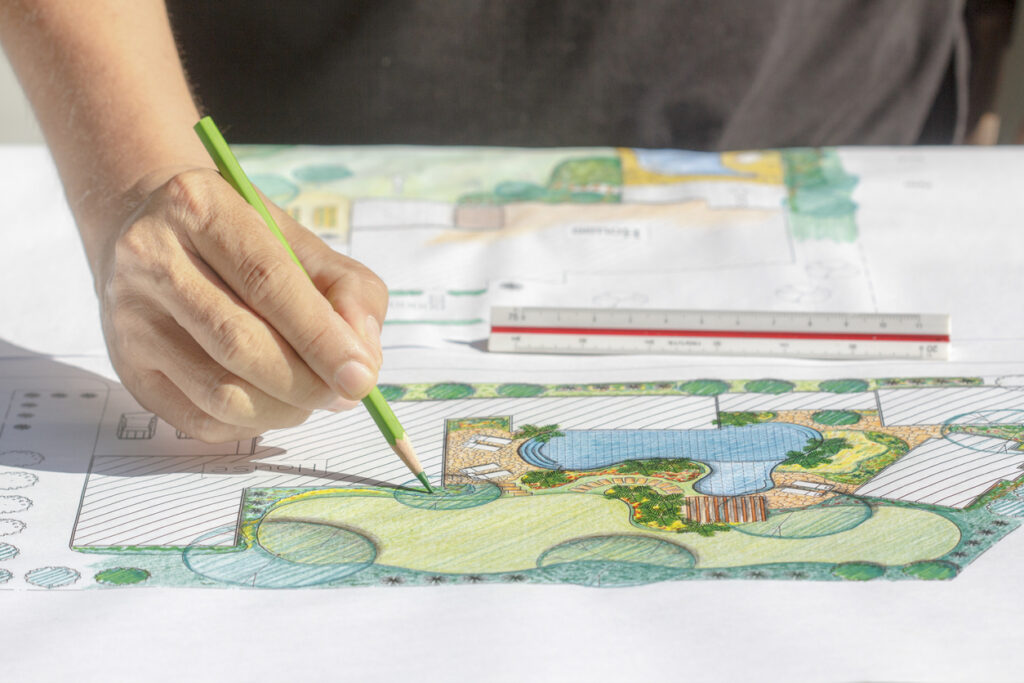If you’ve never attempted landscape design, you might find it overwhelming. What plants should be included, and where should they be placed? Should bed lines and routes be straight or curved? Consider your yard as you would a room in your house since many of the same rules governing how you set up rooms inside also apply to creating spaces outside. Here are landscaping tips to help you start a project.
8 Landscaping Tips
1. Create a Plan
A plot survey of your property, including the backyard and front yard, would be one of the first things a professional landscape designer does after being hired. You can achieve this with little effort. Create an overhead drawing of your property, marking the locations of all the structures, walls, driveways, and other hardscaping elements. The “bones” of your landscape combine your hardscape and other features, such as boulders, trees, and huge bushes.
You can use graph paper to help with this, but a crude sketch around the right proportions will do. The well, septic tank, and underground utility lines should all be marked. Locate the shady and sunny areas of your land using a compass.
2. Make Your Yard a Reality With Careful Financial Planning
Plants add visual appeal and diversity to a yard but can be costly to maintain. The second consideration for amateur landscapers should be the cost of plants. Don’t forget to budget for essentials like seedlings and mulch, ongoing expenses like new tools, fertilizer, and any expert assistance you may need for your garden. Various yards and designs will have different minimum starting prices but plan on spending a few hundred dollars at the absolute least.
Storage costs should be accounted for in the financial plan as well. Although sheds serve a practical purpose, they rarely offer visual appeal, especially when they take up most of the space in a tiny yard. If you don’t have enough room for gardening equipment, supplies, and empty pots, ask a neighbor if they’d mind storing any of your stuff. A neighbor can help you save money on gardening while costing you 50% less than a storage unit.
3. List Your Desires
First, take stock of what you already possess, then make a wish list of the things you still need. In what way do you envision your garden developing? Set some broad objectives to begin with. Here’s an illustration to guide you:
- Do you seek seclusion on a patio?
- Are you looking to hide a less-than-pretty scene?
- Do you care more about a public presentation or a personal presentation?
If you already have flower beds, take stock of what’s doing well and fill in the gaps with the other colors, heights, leaves, and bloom times you’ll need to achieve your design goals. You can use this as a checklist while shopping for plants. If your garden loses its vibrancy after July, you can restrict your plant selection to those that bloom later in the year rather than stocking up on more spring bloomers.
4. Think Big But Make Small Steps
Landing your yard can be difficult if you’ve never done it before. When you take small progressive steps, you see the whole process unfold and appreciate it without getting overwhelmed. If you’re worried about giving up on your landscaping designs, try to divide them into smaller, more manageable chunks.
Making SMART landscaping plans is a smart way to get started. To construct a magnificent garden retreat is a broad and unattainable objective, but planting a flower bed by the end of the month is more concrete and achievable.

5. Hardscape Now, Softscape Later
You should start your landscaping project with hardscaping, including walkways, stairs, sidewalks, and walls built of hard materials. To begin your yard’s softscape, you must first decide which parts will be hardscaped. Many homeowners choose to hardscape with stones like flagstones, but since these materials are expensive, you can use rocks. Rocks are easy to disperse, durable, and aesthetically pleasant, making them perfect for filling up empty spaces in your yard.
Weed barrier cloth, also known as landscaping fabric, should be laid down before any rocks are installed in a landscape design to prevent the need for weed removal later on. Even if you forget to lay down weed barrier cloth, you need not worry about those pesky weeds sprouting back up repeatedly. You can control them with hand cultivation, mulching, heat wilting, or chemicals.
6. Think About Your Watering Plan
When it comes to watering, many people who undertake a landscaping project lose interest, especially since utilizing lawn sprinklers can raise your utility rates. Strategic watering zones that reuse water and conserve it are an excellent concept.
The construction of a rain garden is another approach to reducing watering costs. A rain garden is built so that rainwater is diverted from your home and directed toward your plants. For regions with average to heavy rainfall and humidity, a rain garden is a wise investment that is also economical and kind to the environment.
You might be able to save money on sprinklers by using soaking hoses. Because they distribute water directly to the roots of your plants rather than showering it through the air, soaking hose watering systems are significantly more efficient than conventional sprinklers.
7. Employ Ground Covers and Ornamental Grass
Consider employing ornamental grasses as an alternative to lawn grass if you’re looking for landscaping tips or 0ideas: it’s the laziest landscaper’s best trick. Ornamental grasses allow you to fake it until you reach your lawn when combined with other ground covers. Unlike common lawn grasses, ornamental grasses only require annual trimming. Ornamental grasses, which can withstand heat and drought, come in various colors and textures, covering the entire ground for less money.
8. Preserve and Enjoy
After you have finished designing your ideal outdoor space, you will need to keep up with the upkeep of your yard year-round. While a xeriscaped yard may need occasional weeding, other landscaping will need watering, fertilizing, mulching, and tilling. Completing all of the tasks on your autumn maintenance checklist ensures that your plants survive the winter. Enjoy and be proud of your hard work in landscaping. Relax in the sunshine and take in the scenery.
With a well-planned landscaping strategy, you may space out the labor and cost over a longer period. Don’t let the size of your project discourage you. This is supposed to be enjoyable, so don’t take yourself too seriously. You are making something special just for yourself. Every year, putting in a little work will eventually provide the garden of your dreams. If you need landscape products to realize your goal, contact Quality Accents, we will offer all that you need at a reasonable price.

